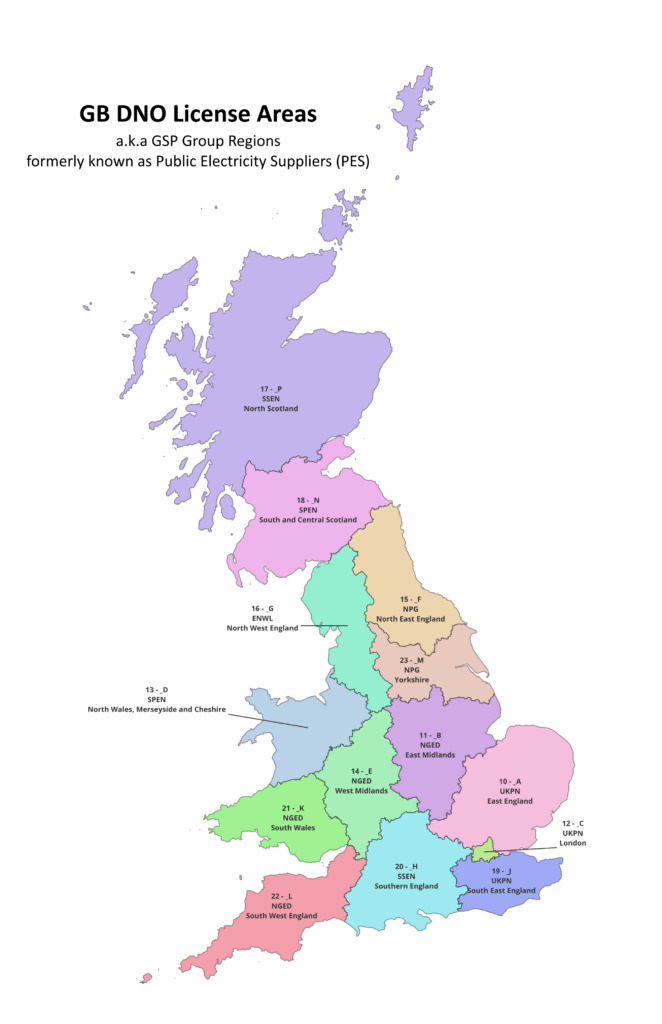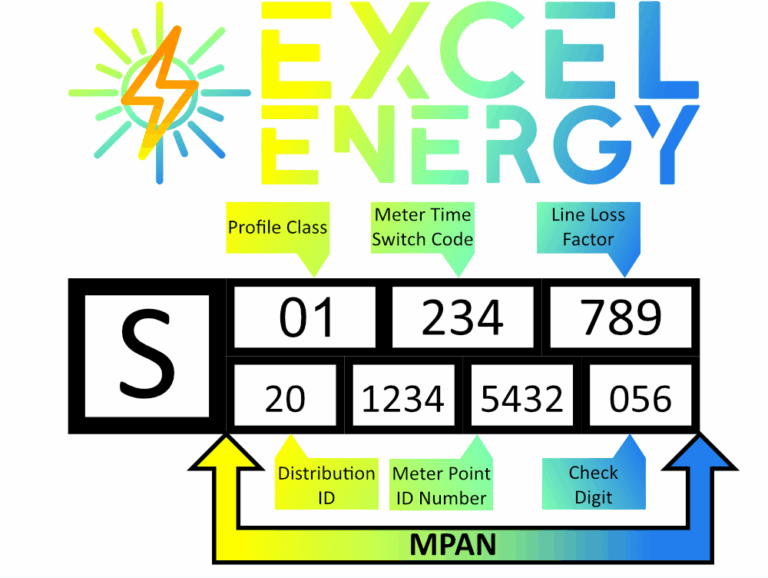What is a DNO application, and why do I need one?
DNO is an abbreviation for “Distribution Network Operator”; a DNO is a company licensed by Ofgem to be responsible for the distribution of power from the National Grid to your property. When installing Commercial Solar Panels, a DNO application of one type or another will be required to connect to the National Grid, as explained later in
The UK is divided into 14 “districts”, each with its own MPAN (Meter Point Administration Number) prefix, and is run by one of 6 DNOs as listed below:
| MPAN Prefix (Distribution ID) | Area | Operator |
| 10 | Eastern England | UK Power Networks |
| 11 | East Midlands | National Grid PLC |
| 12 | London | UK Power Networks |
| 13 | Merseyside & Northern Wales | SP Energy Networks |
| 14 | West Midlands | National Grid PLC |
| 15 | North Eastern England | Northern Powergrid |
| 16 | North Western England | Electricity North West |
| 17 | Northern Scotland | Southern & Scottish Energy |
| 18 | Southern Scotland | SP Energy Networks |
| 19 | South Eastern England | UK Power Networks |
| 20 | Southern England | Southern & Scottish Energy |
| 21 | Southern Wales | National Grid PLC |
| 22 | South Western England | National Grid PLC |
| 23 | Yorkshire | Northern Powergrid |

MPANs for Electricity explained:
An MPAN is a 21-digit number that uniquely identifies your electricity meter and is divided into two lines of information, as shown in the graphic above.
The top line contains technical codes that help your energy provider and DNO recognise how electricity is used and should be charged:
Profile Class: A 2 digit number that divides consumers into 1 of 9 categories based upon consumption and load profile. These consumption patterns monitor patterns in usage to help manage the network and provide better services.









Meter Time Switch Code:
States how many registers your meter has and what times they operate. If your meter has 2 registers, it will also show what times they operate.
Line Loss Factor:
Describes the expected cost that a DNO charges a supplier for use of their cables and electricity network. It also indicates the possible charges a supplier may face due to the loss of energy that occurred during the process of getting the electricity to your meter.

The bottom line contains the primary 13 digits of your MPAN, it identifies which area you are in, a unique number to identify your electricity supply point and a check digit.
✅ Distribution ID: A 2-digit number assigned to each District.
✅ Meter Point ID Number: A unique (per district) 8-digit number that identifies the physical metering point.
✅ Check Digit: 3 digits that validate the previous ones through a formula to prevent errors during data entry or supplier transfers.
G98 vs G99
If your inverter’s AC output is no more than 3.68kW (16 Amps) per phase (Allowing up to 11.04kW of output for a 3 phase property), you can have your inverter connected to the grid and submit a completed G98 DNO application within 28 days of your system being commissioned. This is commonly referred to as a “connect and notify system”, is free of charges, and approval can take up to 8 weeks.
A G99 application can cost £300-750 and is required when this limit would be exceeded. Until you receive approval, the system either cannot be connected to the grid, or the inverters’ output will need to be restricted to 3.68 kW per phase. Approval for a G99 application can take anywhere between 10 & 45 working days, depending on the complexity of the application as is usually best handled by an expert provider, such as Excel Energy UK.
Creating an income stream from surplus Selling Energy




The outcomes of a DNO application
After your DNO application has been received and assessed, the Distribution Network Operator can either accept your system connection as is, reject the proposed installation (though outright rejections are extremely rare), or they will impose what is known as “export limitation” In the first and third cases, you will be sent a connection offer. This includes any limitation figures of the connection and whether there will be any connection charges.
Further details of these outcomes are listed below:
1: Your application is accepted
and your DNO is happy with the size of the system you have requested to install. This means you can proceed with your installation, with no extra charges or amendments.
2: Your application was rejected
and the DNO will not allow your equipment to connect to the grid. But categorical rejections are rare and it is more likely that some additional works are required to be performed to either limit the AC output of the inverter or you will need to pay to upgrade some of the local infrastructure, as seen in points 3a and 3b:
3A: The system size is capped
at a given kWp AC rating, and an export limitation is required, (detailed below). Sometimes, a small fee is charged for a witness test, where your provider ensures a limitation has been put in place to protect the local infrastructure.
3B: Your supply size needs to be upgraded
from a single phase to a three-phase system to go ahead with your solar panel installation. This additional charge can vary greatly depending on the works required.
Export limitation is applied through a 3rd type of application called a “G100”, which costs an additional £300-750 and is typically achieved through fitting an export limitation device to an inverter’s AC output, though a majority of modern inverters also have this functionality built in.
DNO Applications can seem very daunting and complicated, but with a little help from a trusted renewables supplier such as Excel Energy UK Ltd, this process can mostly be handled for you, with only a little information required from you. Contact Excel Energy to start your journey into a greener, more reliable future
